Snowboard boots are engineered with precision to offer a unique blend of support, comfort, and durability. It makes them indispensable for snowboarders. Also, their specialized design, however, raises an interesting query about their versatility beyond the slopes.
Can you wear Snowboard Boots for Walking? Yes, you can technically wear snowboard boots for walking. However, it's not recommended for extended periods due to their design. It prioritizes stability and control for snowboarding over the flexibility and comfort needed for walking.
With insights from experts and a focus on well-established scientific consensus, this guide aims to provide a comprehensive understanding of snowboard boots' capabilities, fostering an informed and enthusiastic snowboarding community.
Understanding Snowboard Boots
Snowboard boots are a critical component of a snowboarder's gear, designed to provide stability, insulation, and a direct transfer of the rider's movements to the snowboard. They come with various lacing systems, including traditional, quick-pull, or Boa, each offering a unique balance of speed, security, and adjustability.
The boots are categorized based on their flex into soft, medium, or stiff, aligning with different riding styles and preferences. Soft boots are typically used for freestyle and park riding, offering more maneuverability. Medium flex boots are versatile, suitable for all types of terrain, and recommended for most riders. Stiff boots provide maximum support and control, ideal for free ride and aggressive all-mountain riding.
The Technology Behind Snowboard Boots
The technology in snowboard boots, such as the Boa Fit System, focuses on delivering a precise, customized fit that enhances performance. This system uses micro-adjustable dials, strong lightweight laces, and low friction lace guides to ensure a secure fit that can be easily adjusted.
The Boa system is designed to withstand tough conditions, offering durability and resilience to force and impact. The choice of lacing system and the boot's flex significantly affect the boot's overall performance and the rider's experience on the mountain.
Can You Walk in Snowboard Boots?
While snowboard boots are specifically engineered for snowboarding, walking in them is technically possible but not recommended for extended periods. The boots are designed to provide ankle support, stability, and weather protection on the slopes, which translates to a lack of flexibility, heavier weight, and a sole design not optimized for walking when off the slopes.
Differences in Walking Comfort Between Soft and Hard Snowboard Boots
The comfort level while walking in snowboard boots varies significantly between soft and hard flex boots. Soft boots, being more flexible and less rigid, offer a slightly more comfortable walking experience than hard boots. However, both types are still bulkier and less suited for walking compared to regular footwear.
Risks and Disadvantages of Using Snowboard Boots for Walking
Walking in snowboard boots can lead to potential injuries and damage to the boots themselves. The rigid design intended for snowboarding can hinder natural foot movements, leading to discomfort and possibly affecting the wearer's gait. Additionally, the boots' durability might be compromised due to wear and tear from walking on hard surfaces, and the lack of proper cushioning and flexibility can increase the risk of foot fatigue and discomfort.
Durability of Snowboard Boots
The durability of snowboard boots depends on the material, construction quality, and how hard they are ridden. On average, a good quality pair of snowboard boots should last between 50 & 70 days of hard riding, which equates to about one to two full seasons for most riders. Boots made from materials like Cordura or leather tend to last longer, especially if maintained properly. However, the boots will start to deteriorate and perform less well over time.
Health and Safety Considerations
Proper fit and support are crucial for both snowboarding and walking. Snowboard boots should be laced tightly yet comfortably, with minimal heel lift to ensure stability and control on the slopes. A well-fitted boot helps prevent injuries and enhances performance.
However, the same level of support and fit required for snowboarding may not be ideal for walking, as snowboard boots are not designed for the range of motion and cushioning needed for comfortable walking.
Care and Maintenance of Snowboard Boots
Tips for Extending the Life of Snowboard Boots
To maximize the lifespan of snowboard boots, it is essential to follow a few maintenance tips. After each use, boots should be dried out completely to prevent the buildup of moisture, which can break down materials and cause unpleasant odors. This can be done by removing the liners and allowing them to air dry, or by using a boot dryer.
Avoid drying them with direct heat, as this can damage the materials. Regularly checking for and repairing any damage, such as worn laces or loose stitching, can also extend the life of the boots. Additionally, applying a waterproofing treatment can help maintain the boots' resistance to moisture.
Importance of Proper Storage and Care to Maintain Boot Integrity
Proper storage is crucial for maintaining the integrity of snowboard boots. They should be stored in a cool, dry place away from direct sunlight, which can degrade the materials over time. It's also important to avoid compressing the boots under heavy objects, as this can deform them and affect their fit and performance. Keeping the boots buckled or laced up while stored can help maintain their shape.
How to Assess When It's Time to Replace Snowboard Boots
You should consider replacing your boots when you feel they no longer provide the necessary support and comfort. Signs that it's time to replace them include over-softening of the boot. It can be anything including lack of response, significant wear and tear on the outer materials, and the breakdown of the sole's tread pattern, which can reduce traction.
If the boots no longer fit properly due to packing out or if they cause discomfort or pain, it's also time to consider a new pair.
Conclusion
While snowboard boots can technically be worn for walking, it is clear that they are not optimized for this purpose. Their rigid design and lack of flexibility can lead to discomfort and potential injuries, as well as accelerated wear and tear.












